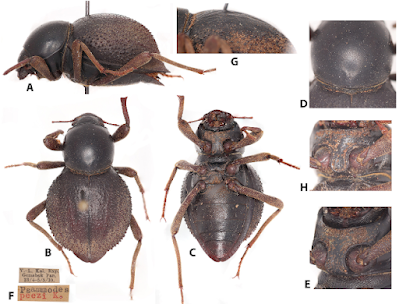Toktokkies are Large Darkling Beetles from Southern Africa, which ger their common name from the distinctive noise they make by tapping their abdomens on the ground. They are stout, flightless Beetles with a chamber beneath the elytra where the wings were once found, used to trap moisture, which then drips down to the Insect's mouth where it can be drunk. This enables them to survive in arid environments such as the Namib Desert, where there are more than 20 species. The large an conspicuous nature of Toktokkies made them attractive to the zoological collectors of the nineteenth and twentieth centuries, resulting in many museums in Europe and North America amassing impressive collections. This is a problem for modern taxonomists, as the type specimens for described species are found in at least 59 institutions scattered around the world, making it hard to compare putative new species to all the species already described.
In a paper published in the journal Zootaxa on 29 April 2024, Marcin Jan Kamiński of the Museum and Institute of Zoology of the Polish Academy of Sciences describes three new species of Toktokkie from the Frey Beetle Collection at the Natural History Museum Basel, one of the world's largest collections of Darkling Beetles.
The first new species is placed in a new genus, Bouchardium, named in honour of Patrice Bouchard of the Canadian National Collection of Insects, Arachnids and Nematodes at Agriculture and Agri-Food Canada, and given the specific name chillygonzalesi, in honour of the Canadian pianist and composer, who goes by the stage name 'Chilly Gonzales'. The species is described on the basis of five specimens from Zimbabwe and Gauteng Province, South Africa.
Specimens of Bouchardium chillygonzalesi reach 20-24 mm in length, with a maximum elytral width of 10-13 mm. The head is prominent with downward-pointing mouthparts, the elytra high and domed. The body is dark brown, with the upper part of the elytra form a disk, also dark brown in colour, with a corrugated red border. The legs are covered by a dense coating of golden hairs.
The second new species is also placed in the genus Bouchardium, and is given the specific name mariae, in honour of Maria Antonina Kamińska, Marcin Jan Kamiński's daughter. The species is described on the basis of a number of specimens collected in Botswana, Gauteng Province (South Africa), Mozambique, and Zimbabwe.
Specimens of Bouchardium mariae are 19-25 mm in length with the elytra having a maximum width of 12-14 mm. The head is prominent with downward-pointing mouthparts, the elytra high and domed. The body is black, with the upper part of the elytra form a disk, also black in colour, with a smooth red border. The legs are covered by a dense coating of golden hairs.
The third new species is placed in the genus Toktokkus, and given the specific name zofiae, in honour of Zofia Irena Kamińska, also Marcin Jan Kamiński's daughter. This species is described on the basis of a single specimen from Gemsbok Pan, in North West Province, South Africa.
The single known specimen of Toktokkus zofiae is 18.5 mm long with a maximum elytral width of 11.0 mm. I he head is prominent with downward-pointing mouthparts, the elytra relatively flattened with flanks covered in microtubercles. The legs are covered by a dense coating of golden hairs.
See also...











%20(1).png)